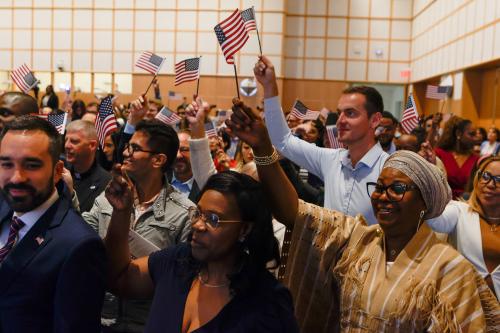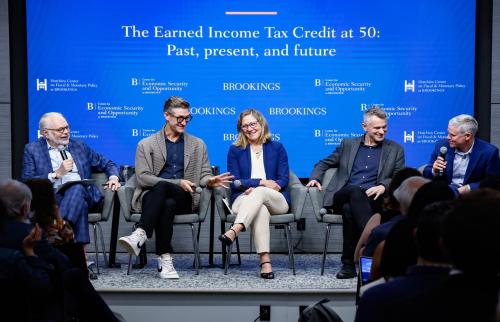This op-ed was originally published by Real Clear Policy on December 16, 2020.
The U.S. is failing to provide economic opportunity to all its citizens. On that, at least, Democrats and Republicans can agree. A key question — arguably the most important question — facing the new Administration and new Congress is: how to improve economic opportunity?
Rising to this challenge will require strong leadership and institutional muscle, along with an investment in using big data, along with a renewed commitment to evidence and evaluation.
Joe Biden should therefore create an Office of Economic Opportunity. Or rather he should restore it: Ronald Reagan abolished it in 1981. The original version, founded in 1964, was a key weapon in the “war on poverty,” incubating programs like Jobs Corp and Head Start.
The 2021 rebooted Office of Economic Opportunity should be explicitly tasked with improving rates of upward economic mobility, by setting high-profile goals for success; measuring progress with regular public reports, drawing especially on linked administrative data; coordinating efforts across the federal government; and rigorously evaluating pilot programs intended to improve opportunity outcomes.
Set national goals for economic mobility
Goal-setting is of course a delicate political task. It is important that goals be strongly grounded empirically. But it is also important that any declared goals are taken seriously, since they can and should act as important commitment devices for policymakers, especially for the pursuit of long-run objectives. An example from overseas is the U.K.’s pledge to first halve child poverty by 2010, and abolish it by 2020. This goal significantly influenced social policy in the U.K. for the first decade of this century under the Labour governments of Tony Blair and Gordon Brown, and even into the new coalition government formed in 2010 (in which I served).
Measure and track mobility
By contrast to other vital national aspirations, such as increasing economic growth or reducing poverty, there are no official measures of economic opportunity that are tracked and published on a regular basis. So one task of the Office of Economic Opportunity is to produce an annual official mobility report, with a selection of different yardsticks. It could also highlight a single measure of progress — and set a clear goal against which to assess progress. If America is supposed to be a land of opportunity, mobility metrics are the measure of the nation.
A key goal, for example, could be to increase the proportion of people born in the bottom fifth of the income distribution rising up to the top fifth as an adult. Right now, that number is 7.5%. Why not aim for 13%, to match Canada? Another measure — absolute as opposed to relative — is the proportion of people who end up doing better economically than their parents. For those born in 1980 the number is 50%, down from 90% for those born in 1940. Perhaps we should aim to get half way back to that high number, setting a goal of 70%? These are of course just examples.
Clearly, shifting the mobility rate will be a long-term, difficult task. So the office should also produce “leading indicators” of likely future mobility trends — shorter-term metrics that can be reliably expected to impact longer-range outcomes.
Coordinate government activities
Economic mobility as a goal for public policy does not sit neatly into a single departmental box. We know that education, housing, racial discrimination, neighborhoods, health, and family stability are all important — which covers almost every department in the Federal government. The new Office should lead the newly-formed interagency Council on Economic Mobility, which has the following goal: “As an interagency group, the Council is focusing on areas that are crosscutting, issues that cannot be accomplished by a single agency on its own, seeking to create an accountable and effective structure for interagency collaboration and using federal authorities to promote family-sustaining careers and economic mobility for low income Americans.”
The interagency Council is an initiative that should not only survive the transition to a new administration, but be given an even higher priority. (Another is the new Commission on the Social Status of Black Men and Boys).
Big data for good
Data matters here — a lot. And because intergenerational mobility is a long-term goal, longitudinal studies are vital. The Office could promote — and if necessary fund — high-quality longitudinal data collection, as well as drawing on administrative data, as the Opportunity Insights team, led by Raj Chetty, have done effectively with IRS and Census data. There are many good ideas on the table here, including the creation of an American Opportunity Survey by linking together various administrative datasets, including the Census, American Community Survey, Survey of Income and Program Participation, as well as data from the IRS and Social Security Administration. Getting the right data from the right stakeholders in a timely fashion is a difficult task for outside researchers — but not for a White House Office.
To that end, the new Advisory Committee on Data for Evidence Building, based in the Office of Management and Budget, should report the head of the new Office of Economic Opportunity, rather than to the Commerce Department’s Office of the Under Secretary for Economic Affairs, as currently proposed.
Pilot, evaluate, then pilot again
A final, beefy role for the restored Office of Economic Opportunity is to assess, pilot and evaluate policies for improving social mobility. Many policies aim to narrow the opportunity gap (i.e., promote upward relative mobility). Whether they work or not is another matter. The Office ought to be evangelical about the ends — intergenerational mobility — but agnostic about the various means to it. What matters is what works. As Chetty said in a podcast conversation with Kara Swisher: “There are lots of questions that are purely scientific questions, that have become political questions because of a lack of clear answers.”
The Office should, then, be provided with sufficient budgetary authority to get some “clear answers,” by commissioning and evaluating pilot programs, and then to adapting and retesting those programs in an ongoing, iterative cycle. The new administration should create an Economic Mobility Impact Fund, modeled on the Social Innovation Fund and combining philanthropic, private and public funds in order to test interventions designed to promote upward mobility. (Note that a similar approach has been proposed by AEI’s Scott Winship). The aim is to provide evidence-based policymaking, as opposed to what official institutions often currently provide, which is policy-based evidence-making.
Politicians should always be wary of thinking that a new office is the answer to every social problem. But an exception can certainly be made in this case. If we needed an Office of Opportunity four decades ago, we sure need one now.
The Brookings Institution is committed to quality, independence, and impact.
We are supported by a diverse array of funders. In line with our values and policies, each Brookings publication represents the sole views of its author(s).







Commentary
Op-edBiden should restore the Office of Economic Opportunity abolished by Reagan
December 17, 2020